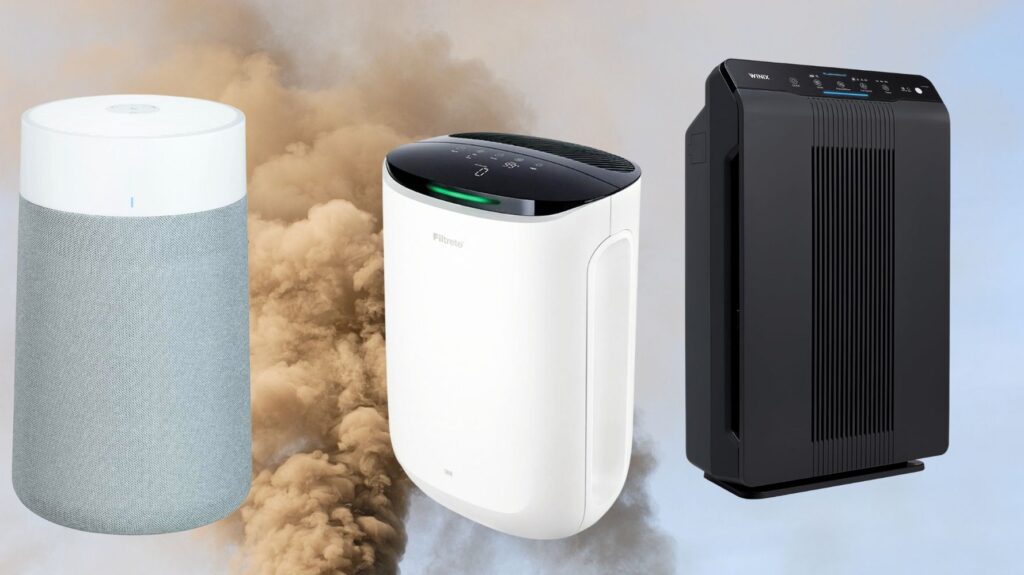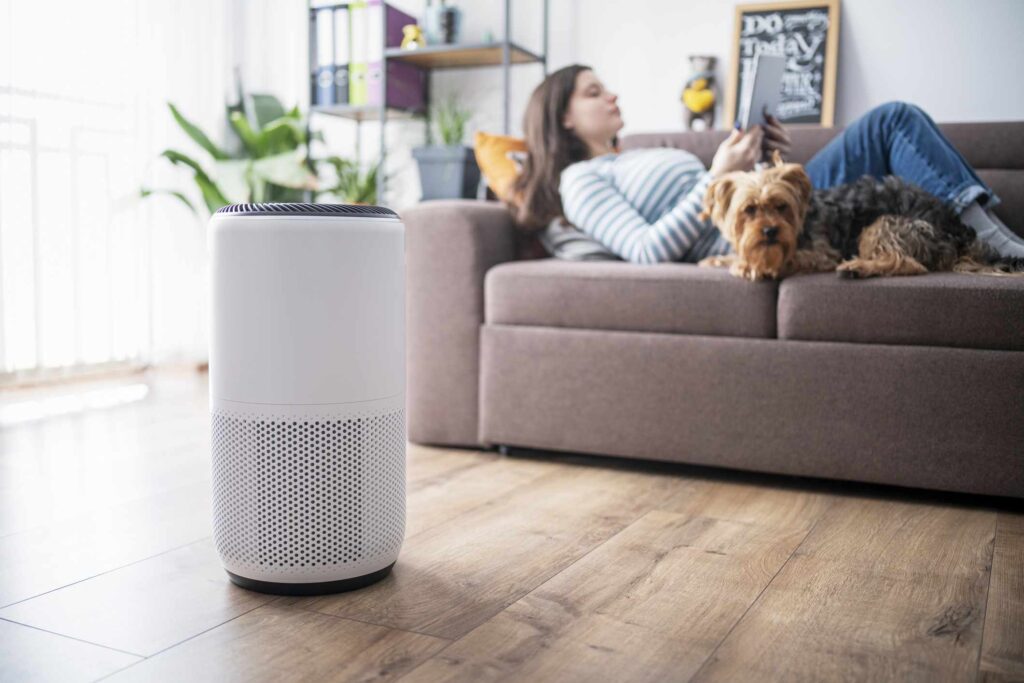Blog
How Air Purifiers Improve Your Home’s Health Environment
The air we breathe plays a crucial role in our overall health and well-being. With increasing pollution levels and indoor air contaminants, maintaining clean air in your home has become more important than ever. Air purifiers are a powerful solution to this problem, helping to eliminate harmful particles, allergens, and odors from the air, thereby creating a healthier home environment.
In this guide, we’ll explore how air purifiers improve your home’s health environment, their benefits, and how to choose the right one for your needs.
1. What Are Air Purifiers?
Air purifiers are devices designed to clean the air by removing harmful pollutants, allergens, and airborne particles. Using advanced filtration systems, they capture contaminants and circulate cleaner air back into your living space.

Key Features of Air Purifiers:
- Multi-Stage Filtration: Includes pre-filters, HEPA filters, and activated carbon filters.
- UV-C Technology: Some models use ultraviolet light to kill bacteria and viruses.
- Smart Features: Offer air quality monitoring, mobile app control, and energy-efficient modes.
- Compact or Large Designs: Available for small rooms or entire homes.
2. Common Indoor Air Pollutants
Air purifiers address a range of indoor air pollutants that can impact your health:
1. Allergens:
- Pollen, pet dander, and dust mites can trigger allergies and asthma symptoms.
2. Particulate Matter (PM):
- Fine particles like PM2.5 from smoke, cooking, and outdoor pollution can damage respiratory health.
3. Mold Spores:
- Common in damp environments, mold spores can exacerbate allergies and respiratory conditions.
4. Volatile Organic Compounds (VOCs):
- Found in cleaning products, paints, and furniture, VOCs can irritate the lungs and cause headaches.
5. Bacteria and Viruses:
- Pathogens in the air can spread illnesses, especially during flu seasons.
6. Odors and Gases:
- Cooking odors, tobacco smoke, and household chemicals contribute to unpleasant indoor air.
3. How Air Purifiers Improve Indoor Air Quality
Air purifiers work by filtering and removing harmful particles and contaminants from the air. Here’s how they contribute to a healthier home environment:

1. Removes Allergens
- HEPA (High-Efficiency Particulate Air) filters capture up to 99.97% of particles as small as 0.3 microns, including pollen, pet dander, and dust mites.
- Reduces allergy symptoms like sneezing, runny nose, and itchy eyes.
2. Eliminates Harmful Particles
- Removes fine particles (PM2.5) that can penetrate deep into the lungs and cause health issues like asthma or bronchitis.
- Ideal for homes near busy roads or in areas with high pollution.
3. Neutralizes Odors and VOCs
- Activated carbon filters absorb gases, smoke, and odors, leaving the air fresh and clean.
- Helps combat the smell of tobacco, cooking, or chemical fumes.
4. Reduces Mold and Mildew
- Prevents the spread of mold spores by trapping them in filters.
- Some purifiers include UV-C light to kill mold and bacteria.
5. Protects Against Viruses and Bacteria
- Advanced models with UV-C light or ionization technology can kill airborne pathogens, reducing the risk of illness.
6. Improves Respiratory Health
- Cleaner air reduces strain on the lungs, especially for those with asthma, COPD, or other respiratory conditions.
- Helps children and the elderly, who are more vulnerable to poor air quality.
4. Health Benefits of Using an Air Purifier
1. Allergy Relief
- Consistent use of air purifiers reduces exposure to allergens, alleviating symptoms of hay fever and pet allergies.
2. Better Sleep
- Cleaner air reduces nighttime coughing and congestion, promoting deeper and more restful sleep.
3. Reduced Risk of Respiratory Diseases
- Minimizes exposure to harmful particles that can lead to chronic respiratory conditions.
4. Enhanced Immune Function
- By removing airborne bacteria and viruses, air purifiers lower the likelihood of infections.
5. Improved Mental Clarity
- Cleaner air contributes to better oxygen flow, which can improve focus and reduce fatigue.
5. Best Air Purifiers for a Healthier Home
Here are some top-rated air purifiers that can significantly improve your indoor air quality:
1. Dyson Pure Cool TP07
Features:
- Combines air purification with a bladeless fan for cooling.
- HEPA and activated carbon filters remove allergens and odors.
- Real-time air quality monitoring via a mobile app.
Best For:
Large rooms and homes needing stylish, multifunctional devices.
2. Blueair Blue Pure 211+
Features:
- Removes 99% of airborne particles, including pollen, dust, and pet dander.
- Energy-efficient and whisper-quiet operation.
- Washable pre-filters for easy maintenance.
Best For:
Medium to large rooms with allergy concerns.
3. Honeywell HPA300
Features:
- True HEPA filter captures 99.97% of particles.
- Covers up to 465 square feet, ideal for large spaces.
- Multiple cleaning modes, including turbo for quick purification.
Best For:
Homes needing powerful purification for larger areas.
4. Levoit Core 300
Features:
- Compact, budget-friendly design with True HEPA filtration.
- Three-stage filtration for allergens, smoke, and odors.
- Quiet operation, perfect for bedrooms or nurseries.
Best For:
Small spaces or first-time air purifier users.
5. Molekule Air Mini+
Features:
- PECO (Photo Electrochemical Oxidation) technology destroys pollutants at a molecular level.
- Tracks air quality in real-time via an app.
- Sleek, portable design.
Best For:
Individuals with severe allergies or chemical sensitivities.
6. How to Choose the Right Air Purifier
When selecting an air purifier, consider the following factors:
1. Room Size:
- Check the device’s Clean Air Delivery Rate (CADR) to match your room size.
2. Filtration System:
- Look for True HEPA filters for allergens and activated carbon for odors and VOCs.
3. Noise Level:
- Choose a quieter model for bedrooms or nurseries.
4. Energy Efficiency:
- Opt for Energy Star-rated purifiers to save on electricity costs.
5. Smart Features:
- Mobile app control, air quality sensors, and timers add convenience.
6. Maintenance Costs:
- Consider the cost and frequency of filter replacements.
7. Tips for Using Air Purifiers Effectively
- Place Strategically: Position the purifier in high-traffic areas or rooms where you spend the most time.
- Keep Doors and Windows Closed: This helps maintain air quality within the room.
- Replace Filters Regularly: Follow the manufacturer’s guidelines for replacing filters to ensure optimal performance.
- Run Continuously: Use the purifier on a low setting throughout the day for consistent air cleaning.
- Monitor Air Quality: Use built-in sensors or apps to track improvements.
8. Limitations of Air Purifiers
While air purifiers are highly effective, they do have some limitations:
- Surface Cleaning Required: Air purifiers don’t clean surfaces; regular dusting and vacuuming are still necessary.
- Limited to Indoor Air: They won’t address outdoor pollution.
- Not a Cure-All: They reduce contaminants but can’t eliminate all risks of illness or allergies.
9. The Future of Air Purification
As technology advances, air purifiers are becoming smarter and more efficient:
- AI-Driven Purification: AI systems will optimize settings based on real-time air quality.
- Integrated Systems: Expect air purification to become a standard feature in HVAC systems.
- Eco-Friendly Materials: Devices will use sustainable materials and energy-saving technologies.
Conclusion
Air purifiers are essential tools for creating a healthier home environment. By removing allergens, pollutants, and pathogens, they improve air quality and promote better health for you and your family. Whether you’re dealing with allergies, respiratory issues, or just want fresher air, investing in a high-quality air purifier is a step toward better living.
Choose the right model for your needs, follow best practices for usage, and enjoy the benefits of cleaner, healthier air in your home.

